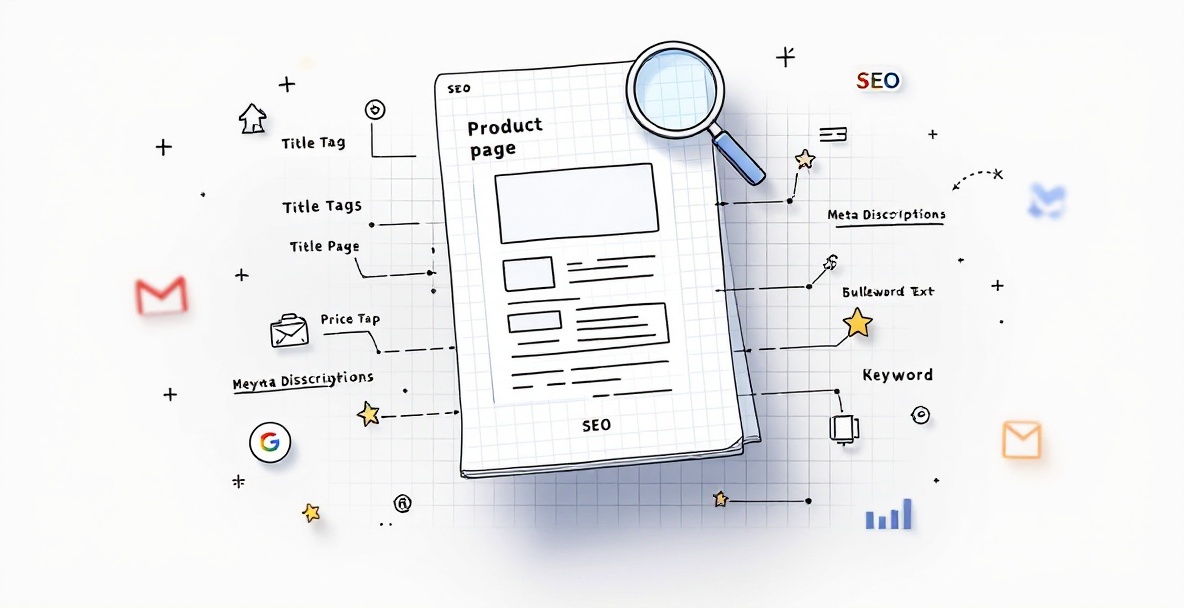In the competitive world of e-commerce, your product pages represent the final battleground where conversions are won or lost. As someone who's analyzed thousands of e-commerce sites at SEO Tuts, I've observed that even minor optimizations to product pages can dramatically impact both search visibility and conversion rates. This comprehensive guide will walk you through proven strategies to transform your product pages into powerful SEO assets that not only attract qualified traffic but convert browsers into buyers.
Understanding the Foundations of Product Page SEO

The Critical Role of Product Pages in E-commerce Success
Product pages serve as the ultimate conversion point in your e-commerce funnel. Unlike category pages that cast a wide net, product pages target users with high purchase intent who are evaluating specific items. These pages must simultaneously satisfy search engines and human visitors by providing comprehensive product information, compelling imagery, trust signals, and seamless purchase options. When properly optimized, product pages become your most valuable digital assets, directly influencing your bottom line through improved visibility and conversion rates.
The success of your product pages hinges on their ability to address the complete buyer journey. Visitors arrive with varying levels of knowledge and purchase readiness. Some need detailed specifications and comparisons, while others seek validation through reviews or guarantees. By structuring product pages to accommodate these diverse needs, you create a frictionless path to purchase that search engines reward with higher rankings.
Search engines have grown increasingly sophisticated in evaluating content quality on product pages. Google's helpful content update specifically targets thin or duplicate product descriptions, making unique, substantive content more important than ever. Product pages that excel in search results consistently demonstrate expertise, address common questions, and provide value beyond basic specifications.
Search Engine Optimization Fundamentals for E-commerce
E-commerce SEO differs significantly from general website optimization. Product pages must balance commercial intent with informational value, all while managing technical challenges unique to e-commerce platforms. The foundation begins with proper site architecture, ensuring products are organized in a logical hierarchy that preserves link equity and simplifies navigation for both users and search engines.
Structured data plays a pivotal role in e-commerce SEO success. Implementing product schema markup allows search engines to understand and display critical information like pricing, availability, reviews, and specifications directly in search results. This enhanced visibility through rich snippets dramatically improves click-through rates and signals content relevance to search algorithms.
Mobile optimization remains non-negotiable for e-commerce sites. With mobile commerce growing exponentially, search engines prioritize mobile-friendly experiences in rankings. Product pages must deliver seamless experiences across devices, with special attention to touch-friendly navigation, properly sized product images, and streamlined checkout processes that minimize friction on smaller screens.
Technical Optimization for Product Pages

Technical SEO Audit Checklist for Product Pages
Before implementing on-page improvements, conduct a comprehensive technical audit of your product pages to identify and resolve underlying issues. Begin by examining URL structures, ensuring they follow a consistent pattern that includes relevant keywords while remaining concise and readable. Avoid parameter-heavy URLs that dilute relevance signals and complicate indexing.
Next, analyze your internal linking structure to ensure critical product pages receive adequate link equity. Each product should be accessible within a maximum of three clicks from your homepage. Strategic internal linking not only improves discoverability but also establishes content relationships that help search engines understand your site hierarchy.
Duplicate content represents a significant challenge for e-commerce sites, particularly those with large product catalogs featuring similar items. Implement canonical tags to designate preferred versions when multiple URLs display identical or substantially similar content. For discontinued products, consider implementing 301 redirects to relevant alternatives rather than returning 404 errors, preserving accumulated link equity.
Website Crawlability Improvement Techniques
Optimizing your site's crawl budget ensures search engines efficiently discover and index your most valuable pages. Begin by creating comprehensive XML sitemaps organized by product categories and update them automatically when new products are added or existing ones modified. Submit these sitemaps through Google Search Console and monitor crawl statistics to identify potential indexing issues.
Implement a logical faceted navigation system that prevents the creation of countless URL variations. Use robots.txt directives or meta robots tags to prevent crawling of filtered result pages that generate minimal unique value, such as multiple sorting options or highly specific filter combinations. This prevents dilution of your crawl budget and focuses search engine attention on your most valuable pages.
JavaScript frameworks have become increasingly common in e-commerce development, but they present unique crawling challenges. Ensure critical content and links are accessible without JavaScript execution, or implement server-side rendering to improve content accessibility. Regularly test your site with JavaScript disabled to identify potential crawling barriers that might prevent proper indexing.
Website Speed Optimization Guide
Page speed directly impacts both search rankings and conversion rates, making it a critical factor in product page optimization. Begin by optimizing image delivery through proper sizing, compression, and implementation of lazy loading for below-the-fold content. Consider adopting next-generation formats like WebP that provide superior compression without sacrificing quality.
Minimize render-blocking resources by deferring non-essential JavaScript and CSS, allowing browsers to render visible content more quickly. Implement critical CSS inline to accelerate initial rendering while loading remaining styles asynchronously. For JavaScript-heavy features like image zooms or color selectors, load these components only when users interact with them rather than during initial page load.
Server response time significantly impacts perceived performance. Implement caching solutions at both server and browser levels to reduce processing requirements and delivery times. Consider adopting a content delivery network (CDN) to distribute assets closer to users, particularly if you serve an international audience. Modern hosting environments optimized for e-commerce platforms can dramatically improve TTFB (Time To First Byte) metrics.
Content and Keyword Strategy for Product Pages

Advanced Keyword Research Methods
Effective product page optimization begins with comprehensive keyword research that goes beyond basic search volume metrics. Analyze search intent by examining current top-ranking pages for your target keywords to understand what information users expect. Product-focused keywords often carry transactional intent, while long-tail variations frequently indicate research stages in the buying journey.
Competitive keyword analysis provides valuable insights into market positioning opportunities. Identify content gaps by comparing your product pages against competitors, looking for valuable information they've omitted. These gaps represent opportunities to create superior content that addresses unmet user needs while potentially capturing additional keyword rankings.
Voice search continues to reshape keyword strategies for product pages. Incorporate natural language phrases and question-based content that aligns with conversational queries. Focus particularly on specific product attributes and comparison questions that shoppers commonly ask, such as "Is [Product A] better than [Product B]?" or "Does [Product] work with [Compatibility Question]?"
Content Creation Strategy Template
Successful product page content balances comprehensive information with compelling sales messaging. Begin with unique, detailed product descriptions that highlight key features and benefits while incorporating primary and secondary keywords naturally. Avoid manufacturer-provided descriptions that create duplicate content issues across multiple retailers.
Develop a consistent content structure that prioritizes the most important information above the fold while providing detailed specifications further down the page. Implement expandable sections to accommodate comprehensive details without overwhelming initial visitors. This progressive disclosure approach satisfies both casual browsers and detail-oriented researchers.
User-generated content significantly enhances product page credibility and keyword coverage. Implement robust review systems that encourage detailed feedback rather than simple star ratings. Customer questions and answers provide additional opportunities to incorporate long-tail keywords while addressing common concerns that might otherwise prevent purchases.
Authority Building Through Content
Establishing topical authority around your products requires content that demonstrates expertise beyond basic descriptions. Create enhanced content sections addressing common use cases, troubleshooting advice, or compatibility information. This supplemental content answers questions searchers might have before purchasing while providing valuable keyword opportunities.
Consider implementing comparison tables that contrast your products with alternatives, highlighting your competitive advantages while providing valuable research tools for potential customers. By addressing comparison searches directly on your product pages, you capture additional traffic while controlling the narrative around product differences.
Leverage multimedia content to enhance engagement and provide alternative information formats. High-quality product videos demonstrating usage, unboxing experiences, or setup procedures improve time-on-page metrics while catering to visual learners. These assets also create opportunities for additional search visibility through video search results.
Performance Tracking and Optimization

SEO Benchmarking Performance Metrics
Establishing meaningful benchmarks allows you to accurately measure the impact of your optimization efforts. Track key performance indicators including organic traffic, click-through rates from search results, conversion rates, and revenue attribution from organic channels. Segment these metrics by product categories to identify patterns and prioritize further optimization efforts.
Implement regular position tracking for target keywords to monitor ranking improvements and identify potential issues before they significantly impact traffic. Pay particular attention to featured snippet opportunities, where optimized content can dramatically increase visibility through position zero placements above traditional organic results.
Core Web Vitals have become critical ranking factors for e-commerce sites. Establish benchmarks for Largest Contentful Paint (LCP), First Input Delay (FID), and Cumulative Layout Shift (CLS) scores across your product pages. Monitor these metrics through Google Search Console and implement targeted improvements to address specific performance shortfalls.
Conversion Rate Optimization Tactics
SEO success ultimately translates to business impact through conversions. Implement structured A/B testing to optimize critical elements including product images, call-to-action buttons, pricing displays, and content organization. Small improvements in conversion rates often generate greater revenue impact than ranking improvements alone.
Enhance product confidence through strategic trust signals including detailed shipping information, clear return policies, security badges, and authentic customer reviews. Position these elements prominently on product pages to address common purchase hesitations before they arise. Each removed friction point increases the likelihood of conversion from organic traffic.
Analyze user behavior through heat mapping and session recordings to identify potential usability issues that prevent conversions. Pay particular attention to scroll depth, interaction with key page elements, and abandonment points. These insights reveal opportunities to restructure content or redesign elements to better align with actual user behavior.
Data-Driven Marketing Decision Making
Implement proper attribution modeling to accurately value the contribution of organic search to your conversion funnel. Multi-touch attribution provides a more accurate picture than last-click models, particularly for considered purchases where users may research products across multiple sessions before converting.
Leverage search query data from Google Search Console to identify emerging trends and user interests. Analysis of which queries drive impressions versus clicks reveals potential content gaps or misalignment between search intent and your current product positioning. These insights should inform ongoing content optimization and expansion.
Cross-channel analysis provides a holistic view of your marketing effectiveness. Examine how organic search traffic interacts with other channels including paid search, social media, and email marketing. Understanding these relationships helps allocate resources effectively and create integrated strategies that leverage channel strengths.
Implementation and Next Steps
Creating Your Optimization Roadmap
Effective implementation requires prioritization based on potential impact and resource requirements. Begin by addressing critical technical issues that may be hampering search performance, particularly crawling barriers or page speed issues that affect entire sections of your site.
Develop a content optimization schedule that prioritizes high-value products based on margins, conversion potential, and competitive opportunity. Create templates and workflows that streamline the optimization process, allowing you to efficiently update large product catalogs over time without sacrificing quality.
Build cross-departmental alignment to ensure SEO considerations are integrated into product launches, merchandising decisions, and site development. Establish clear protocols for how new products are added to the catalog, ensuring proper optimization from launch rather than requiring retroactive improvements.
Measuring and Maintaining Success
Implement regular audit schedules to monitor ongoing performance and identify new optimization opportunities. E-commerce sites constantly evolve, and regular technical assessments prevent the accumulation of issues that can gradually erode search performance.
Establish competitive monitoring protocols to track changes in competitor strategies and search landscape evolution. Regular analysis of top-ranking pages for your priority keywords reveals emerging content trends and new user expectations that should inform your ongoing optimization efforts.
Document successful optimization tactics and results to build internal knowledge repositories and demonstrate ROI. Creating case studies from your wins helps secure continued resources for SEO initiatives while providing valuable reference materials for training team members and maintaining consistent implementation.
Product page optimization represents an ongoing commitment rather than a one-time project. As search algorithms evolve and user expectations shift, successful e-commerce businesses continuously refine their approach based on performance data and emerging best practices.
Ready to transform your e-commerce product pages into powerful conversion engines? Visit SEO Tuts today to access our complete library of step-by-step tutorials, technical audit templates, and expert guidance specifically designed for e-commerce optimization success.
Leave a Reply